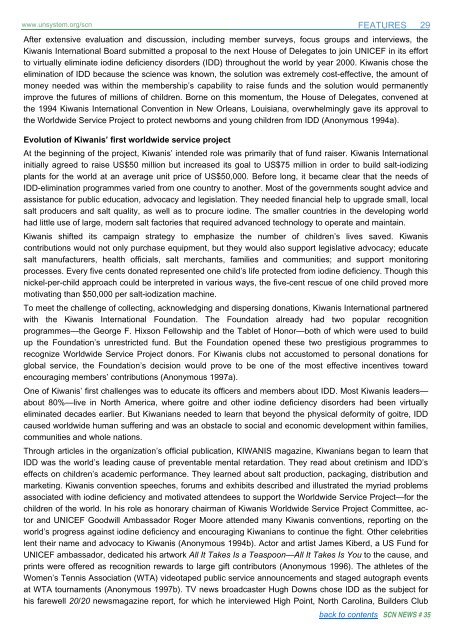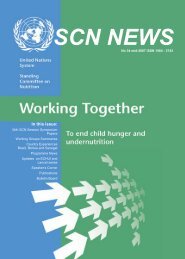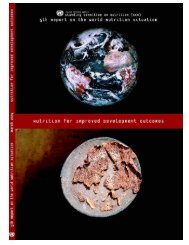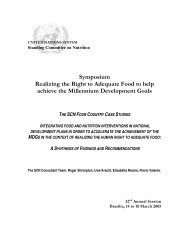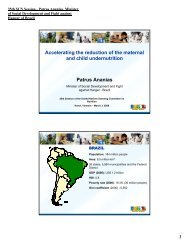Universal Salt Iodization (USI) - FTP Directory Listing
Universal Salt Iodization (USI) - FTP Directory Listing
Universal Salt Iodization (USI) - FTP Directory Listing
- No tags were found...
You also want an ePaper? Increase the reach of your titles
YUMPU automatically turns print PDFs into web optimized ePapers that Google loves.
www.unsystem.org/scn FEATURES 29After extensive evaluation and discussion, including member surveys, focus groups and interviews, theKiwanis International Board submitted a proposal to the next House of Delegates to join UNICEF in its effortto virtually eliminate iodine deficiency disorders (IDD) throughout the world by year 2000. Kiwanis chose theelimination of IDD because the science was known, the solution was extremely cost-effective, the amount ofmoney needed was within the membership’s capability to raise funds and the solution would permanentlyimprove the futures of millions of children. Borne on this momentum, the House of Delegates, convened atthe 1994 Kiwanis International Convention in New Orleans, Louisiana, overwhelmingly gave its approval tothe Worldwide Service Project to protect newborns and young children from IDD (Anonymous 1994a).Evolution of Kiwanis’ first worldwide service projectAt the beginning of the project, Kiwanis’ intended role was primarily that of fund raiser. Kiwanis Internationalinitially agreed to raise US$50 million but increased its goal to US$75 million in order to build salt-iodizingplants for the world at an average unit price of US$50,000. Before long, it became clear that the needs ofIDD-elimination programmes varied from one country to another. Most of the governments sought advice andassistance for public education, advocacy and legislation. They needed financial help to upgrade small, localsalt producers and salt quality, as well as to procure iodine. The smaller countries in the developing worldhad little use of large, modern salt factories that required advanced technology to operate and maintain.Kiwanis shifted its campaign strategy to emphasize the number of children’s lives saved. Kiwaniscontributions would not only purchase equipment, but they would also support legislative advocacy; educatesalt manufacturers, health officials, salt merchants, families and communities; and support monitoringprocesses. Every five cents donated represented one child’s life protected from iodine deficiency. Though thisnickel-per-child approach could be interpreted in various ways, the five-cent rescue of one child proved moremotivating than $50,000 per salt-iodization machine.To meet the challenge of collecting, acknowledging and dispersing donations, Kiwanis International partneredwith the Kiwanis International Foundation. The Foundation already had two popular recognitionprogrammes—the George F. Hixson Fellowship and the Tablet of Honor—both of which were used to buildup the Foundation’s unrestricted fund. But the Foundation opened these two prestigious programmes torecognize Worldwide Service Project donors. For Kiwanis clubs not accustomed to personal donations forglobal service, the Foundation’s decision would prove to be one of the most effective incentives towardencouraging members’ contributions (Anonymous 1997a).One of Kiwanis’ first challenges was to educate its officers and members about IDD. Most Kiwanis leaders—about 80%—live in North America, where goitre and other iodine deficiency disorders had been virtuallyeliminated decades earlier. But Kiwanians needed to learn that beyond the physical deformity of goitre, IDDcaused worldwide human suffering and was an obstacle to social and economic development within families,communities and whole nations.Through articles in the organization’s official publication, KIWANIS magazine, Kiwanians began to learn thatIDD was the world’s leading cause of preventable mental retardation. They read about cretinism and IDD’seffects on children’s academic performance. They learned about salt production, packaging, distribution andmarketing. Kiwanis convention speeches, forums and exhibits described and illustrated the myriad problemsassociated with iodine deficiency and motivated attendees to support the Worldwide Service Project—for thechildren of the world. In his role as honorary chairman of Kiwanis Worldwide Service Project Committee, actorand UNICEF Goodwill Ambassador Roger Moore attended many Kiwanis conventions, reporting on theworld’s progress against iodine deficiency and encouraging Kiwanians to continue the fight. Other celebritieslent their name and advocacy to Kiwanis (Anonymous 1994b). Actor and artist James Kiberd, a US Fund forUNICEF ambassador, dedicated his artwork All It Takes Is a Teaspoon—All It Takes Is You to the cause, andprints were offered as recognition rewards to large gift contributors (Anonymous 1996). The athletes of theWomen’s Tennis Association (WTA) videotaped public service announcements and staged autograph eventsat WTA tournaments (Anonymous 1997b). TV news broadcaster Hugh Downs chose IDD as the subject forhis farewell 20/20 newsmagazine report, for which he interviewed High Point, North Carolina, Builders Clubback to contents SCN NEWS # 35


